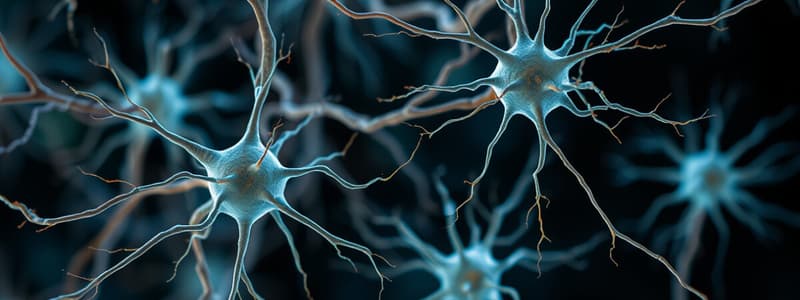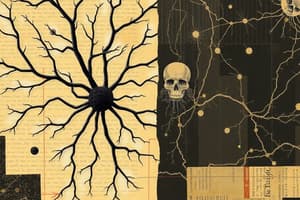Podcast
Questions and Answers
Distinguish between neurons and neuroglia.
Distinguish between neurons and neuroglia.
Neurons are the structural and functional cells reacting to changes in their environment. Neuroglia are supporting cells necessary for nourishing and maintaining the neurons.
What are dendrites?
What are dendrites?
Branchlike parts of a neuron that are specialized to receive information.
What are chromatophilic substances (Nissl bodies)?
What are chromatophilic substances (Nissl bodies)?
They correspond to rough endoplasmic reticulum in other cells.
What is an axon?
What is an axon?
What is the cell body of a neuron?
What is the cell body of a neuron?
What are neurofilaments?
What are neurofilaments?
What do Schwann cells and oligodendrocytes have in common?
What do Schwann cells and oligodendrocytes have in common?
How do Schwann cells and oligodendrocytes differ?
How do Schwann cells and oligodendrocytes differ?
Distinguish between myelinated and unmyelinated axons.
Distinguish between myelinated and unmyelinated axons.
How may an injured neuron regenerate?
How may an injured neuron regenerate?
How is information passed from a presynaptic neuron to a postsynaptic neuron?
How is information passed from a presynaptic neuron to a postsynaptic neuron?
What triggers the release of neurotransmitter at the synaptic knob?
What triggers the release of neurotransmitter at the synaptic knob?
Explain the relationship between an action potential and impulse conduction down an axon.
Explain the relationship between an action potential and impulse conduction down an axon.
What is the importance of the nodes of Ranvier in nerve impulse conduction?
What is the importance of the nodes of Ranvier in nerve impulse conduction?
How do enzymes within the synaptic cleft prevent continuous stimulation of the postsynaptic cell?
How do enzymes within the synaptic cleft prevent continuous stimulation of the postsynaptic cell?
What are the general functions of the nervous system?
What are the general functions of the nervous system?
Describe structural and functional differences among neurons.
Describe structural and functional differences among neurons.
Identify the types of neuroglia in the CNS and their functions.
Identify the types of neuroglia in the CNS and their functions.
What prevents a postsynaptic cell from being continuously stimulated?
What prevents a postsynaptic cell from being continuously stimulated?
Flashcards are hidden until you start studying
Study Notes
Neurons vs. Neuroglia
- Neurons are the primary signaling cells in the nervous system, responding to changes in the environment.
- Neuroglia serves as supporting cells, nurturing and maintaining neurons.
Dendrites
- Dendrites are specialized, branchlike structures that receive information from other neurons.
Chromatophilic Substance
- Known as Nissl bodies, they correspond to rough endoplasmic reticulum and are involved in protein synthesis.
Axon
- An axon is a long, threadlike extension that carries nerve impulses away from the neuron's cell body.
Cell Body
- The largest part of a neuron containing the nucleus and cytoplasm, crucial for cell function.
Neurofilaments
- Fine structures within the neuron’s cytoplasm that provide structural support to the cell membrane.
Schwann Cells vs. Oligodendrocytes
- Both are types of neuroglial cells; Schwann cells are in the peripheral nervous system (PNS), while oligodendrocytes are in the central nervous system (CNS).
- Schwann cells form myelin sheaths around large axons, while oligodendrocytes produce myelin for multiple axons.
Myelinated vs. Unmyelinated Axons
- Myelinated axons are wrapped in myelin sheaths formed by Schwann cells, appearing white.
- Unmyelinated axons lack myelin sheaths and appear gray, with Schwann cells only forming grooves.
Neuron Regeneration
- An injured neuron's distal portion deteriorates; macrophages clear debris.
- The proximal axon develops sprouts guided by nerve growth factors, potentially reconnecting if they grow into the original matrix.
Synaptic Transmission
- Nerve impulses are transmitted at synapses, where the presynaptic neuron stimulates or inhibits the postsynaptic neuron.
Calcium Ions in Neurotransmitter Release
- The influx of calcium ions into the synaptic knob is essential for releasing neurotransmitters.
Action Potential and Impulse Conduction
- An action potential sends an electrical impulse sequentially along the axon, maintaining its amplitude, resulting in nerve impulse propagation.
Nodes of Ranvier and Impulse Conduction
- Myelinated fibers conduct impulses via saltatory conduction, jumping between nodes, while unmyelinated fibers conduct impulses more slowly across the entire surface.
Role of Enzymes in Synaptic Cleft
- Enzymes in the synaptic cleft decompose neurotransmitters rapidly, preventing prolonged stimulation of postsynaptic cells.
General Functions of the Nervous System
- Sensory: Detects changes in the environment.
- Integrative: Combines sensory input for sensations and thought.
- Motor: Communicates information from the CNS to effectors (muscles and glands).
Structural and Functional Differences Among Neurons
- Multipolar: One axon and multiple dendrites; primarily in the CNS.
- Unipolar: One process split into two branches for sensory information.
- Bipolar: Two processes; one axon and one dendrite, found in certain sensory pathways.
Types of Neuroglia in the CNS
- Astrocytes: Support neuron structure, regulate ion concentration, and respond to brain injury.
- Oligodendrocytes: Form myelin in the CNS and can myelinate multiple axons.
- Microglia: Mediate immune responses by phagocytizing debris and bacteria.
- Ependymal cells: Line the central canal and ventricles, may have cilia for fluid movement.
Postsynaptic Cell Stimulation Prevention
- Enzymatic action and neurotransmitter reuptake mechanisms ensure that stimulation of postsynaptic cells is brief and controlled.
Studying That Suits You
Use AI to generate personalized quizzes and flashcards to suit your learning preferences.




